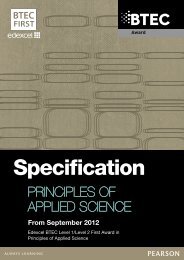BTEC First Award in Application of Science - specification - Edexcel
BTEC First Award in Application of Science - specification - Edexcel
BTEC First Award in Application of Science - specification - Edexcel
You also want an ePaper? Increase the reach of your titles
YUMPU automatically turns print PDFs into web optimized ePapers that Google loves.
ANNEXES<br />
GCSE Mathematics subject content area<br />
The topic areas below are drawn from the GCSE Mathematics subject criteria.<br />
Learners should be able to:<br />
1 understand number size and scale and the quantitative relationship<br />
between units<br />
2 understand when and how to use estimation<br />
3 carry out calculations <strong>in</strong>volv<strong>in</strong>g +, –, ×, ÷, either s<strong>in</strong>gly or <strong>in</strong> comb<strong>in</strong>ation,<br />
decimals, fractions, percentages and positive whole number powers<br />
4 understand and use number operations and the relationships between them,<br />
<strong>in</strong>clud<strong>in</strong>g <strong>in</strong>verse operations and the hierarchy <strong>of</strong> operations<br />
5 provide answers to calculations to an appropriate degree <strong>of</strong> accuracy, <strong>in</strong>clud<strong>in</strong>g<br />
a given power <strong>of</strong> ten, number <strong>of</strong> decimal places and significant figures<br />
6 understand and use the symbols =, , ~<br />
7 understand and use direct proportion and simple ratios<br />
8 calculate arithmetic means<br />
9 understand and use common measures and simple compound measures such<br />
as speed<br />
10 make sensible estimates <strong>of</strong> a range <strong>of</strong> measures <strong>in</strong> everyday sett<strong>in</strong>gs and choose<br />
appropriate units for estimat<strong>in</strong>g or carry<strong>in</strong>g out measurement<br />
11 <strong>in</strong>terpret scales on a range <strong>of</strong> measur<strong>in</strong>g <strong>in</strong>struments, work out time <strong>in</strong>tervals<br />
and recognise that measurements given to the nearest whole unit may be<br />
<strong>in</strong>accurate by up to one half <strong>in</strong> either direction<br />
12 plot and draw graphs (l<strong>in</strong>e graphs, bar charts, pie charts, scatter graphs,<br />
histograms) select<strong>in</strong>g appropriate scales for the axes<br />
13 substitute numerical values <strong>in</strong>to simple formulae and equations us<strong>in</strong>g<br />
appropriate units<br />
14 translate <strong>in</strong>formation between graphical and numerical form<br />
15 design and use data-collection sheets, <strong>in</strong>clud<strong>in</strong>g questionnaires, for grouped,<br />
discrete or cont<strong>in</strong>uous data, process, represent, <strong>in</strong>terpret and discuss the data<br />
16 extract and <strong>in</strong>terpret <strong>in</strong>formation from charts, graphs and tables<br />
17 understand the idea <strong>of</strong> probability<br />
18 calculate area and perimeters <strong>of</strong> shapes made from triangles and rectangles<br />
19 calculate volumes <strong>of</strong> right prisms and <strong>of</strong> shapes made from cubes and cuboids<br />
20 use Pythagoras’ theorem <strong>in</strong> 2-D<br />
21 use calculators effectively and efficiently.<br />
In addition, level 2 learners should be able to:<br />
22 <strong>in</strong>terpret, order and calculate with numbers written <strong>in</strong> standard form<br />
23 carry out calculations <strong>in</strong>volv<strong>in</strong>g negative powers (only -1 for rate <strong>of</strong> change)<br />
24 change the subject <strong>of</strong> an equation<br />
25 understand and use <strong>in</strong>verse proportion<br />
26 understand and use percentiles and deciles<br />
27 use Pythagoras’ theorem <strong>in</strong> 2-D and 3-D<br />
28 use trigonometric ratios to solve 2-D and 3-D problems.<br />
86<br />
BF029957 – Specification – <strong>Edexcel</strong> <strong>BTEC</strong> Level 1/Level 2 <strong>First</strong> <strong>Award</strong> <strong>in</strong> <strong>Application</strong> <strong>of</strong> <strong>Science</strong> –<br />
Issue 1 – March 2012 © Pearson Education Limited 2012








